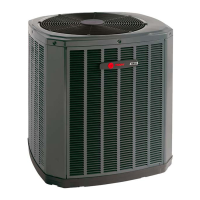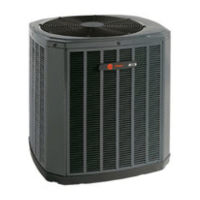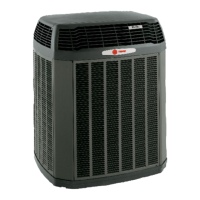Do you have a question about the Trane 4TTR4 and is the answer not in the manual?
Intended for experienced individuals; improper repair can cause injury or damage.
Recommends Trane approved matched indoor and outdoor systems for maximum efficiency.
Warns about higher pressures of R-410A and the need for proper service equipment.
Advises using only R-410A refrigerant and approved POE compressor oil.
Details requirements for unit placement, airflow, and support.
Emphasizes that existing refrigerant line joints must be brazed, not soldered.
Warns that compressor dome temperatures can be hot and may cause burns.
Advises extreme caution when opening the liquid line service valve due to pressure.
Steps for brazing refrigerant lines, including cleaning and minimizing bends.
Do not allow uninsulated liquid line to touch the gas line directly.
Recommends removing valve core and using a wet rag to prevent heat damage during brazing.
Advises using dry nitrogen purge and flux-free brazing alloy for field line connections.
Details how to pressurize lines with nitrogen and check for leaks using soap bubbles.
Steps for evacuating the system using a vacuum pump and micron gauge.
Explicit instruction not to vent refrigerant into the atmosphere.
Instructions on how to open the liquid line shut-off valve with a hex wrench.
Caps must be replaced on valve stems and pressure taps to prevent leaks.
Emphasizes exercising basic safety precautions to avoid electric shock during installation.
Specifies wire size and maximum wire length for low voltage control wiring.
Procedure for starting the compressor, including thermostat settings and power application.
Outlines final installation steps including unit inspection and operational checks.
Requirement for installing a seacoast shield for units near salt water.
A chart detailing system faults and potential causes for troubleshooting.
Explains the symbols used in the wiring diagrams (factory vs. field wiring).
Important notes regarding power supply, grounding, wire size, and thermostat settings.
Table correlating liquid temperature and pressure for R-410A refrigerant charging.
Chart for adjusting subcool charging pressure based on line length and height.
Table listing dimensions (A-K) for different 4TTR4 models.
Detailed diagram showing mounting hole locations and dimensions for bases 3 and 4.
A checklist of final inspection and operational checks for the installed system.
Confirms that refrigerant lines have been checked for leaks.
Ensures suction lines and fittings are properly insulated.
Verifies that all refrigerant lines are secured and isolated correctly.
Checks if supply registers and return grilles are open and unobstructed.
Advises checking thermostat thermometer accuracy against a reliable thermometer.
Recommends operating the complete system in each mode to ensure safe operation.
| Refrigerant | R-410A |
|---|---|
| Voltage | 208/230V |
| Phase | 1 |
| Type | Air Conditioner |
| Cooling Capacity | 18, 000 - 60, 000 BTU/h (1.5 - 5 tons) |
| Cooling Stages | Single-Stage |












